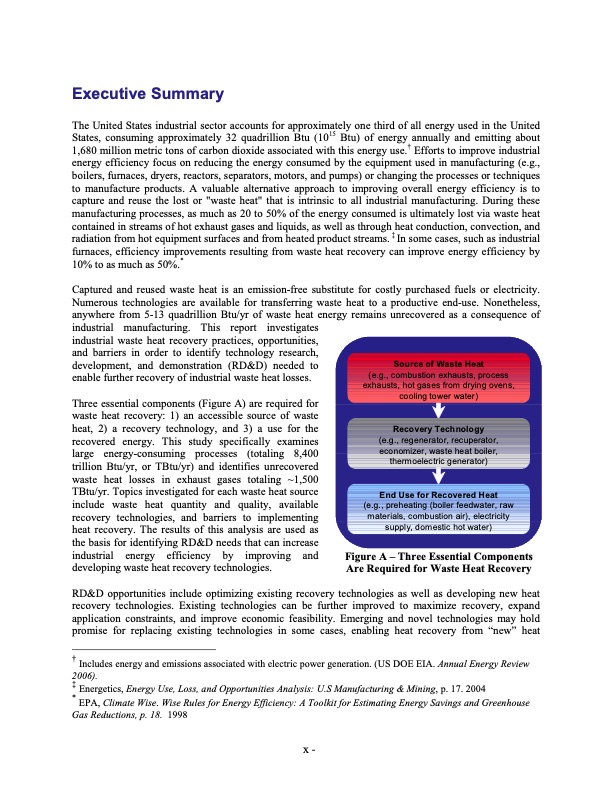
PDF Publication Title:
Text from PDF Page: 010
Executive Summary The United States industrial sector accounts for approximately one third of all energy used in the United States, consuming approximately 32 quadrillion Btu (1015 Btu) of energy annually and emitting about 1,680 million metric tons of carbon dioxide associated with this energy use.† Efforts to improve industrial energy efficiency focus on reducing the energy consumed by the equipment used in manufacturing (e.g., boilers, furnaces, dryers, reactors, separators, motors, and pumps) or changing the processes or techniques to manufacture products. A valuable alternative approach to improving overall energy efficiency is to capture and reuse the lost or "waste heat" that is intrinsic to all industrial manufacturing. During these manufacturing processes, as much as 20 to 50% of the energy consumed is ultimately lost via waste heat contained in streams of hot exhaust gases and liquids, as well as through heat conduction, convection, and radiation from hot equipment surfaces and from heated product streams. ‡ In some cases, such as industrial furnaces, efficiency improvements resulting from waste heat recovery can improve energy efficiency by 10% to as much as 50%.* Captured and reused waste heat is an emissionfree substitute for costly purchased fuels or electricity. Numerous technologies are available for transferring waste heat to a productive enduse. Nonetheless, anywhere from 513 quadrillion Btu/yr of waste heat energy remains unrecovered as a consequence of industrial manufacturing. This report investigates industrial waste heat recovery practices, opportunities, and barriers in order to identify technology research, development, and demonstration (RD&D) needed to enable further recovery of industrial waste heat losses. Three essential components (Figure A) are required for waste heat recovery: 1) an accessible source of waste heat, 2) a recovery technology, and 3) a use for the recovered energy. This study specifically examines large energyconsuming processes (totaling 8,400 trillion Btu/yr, or TBtu/yr) and identifies unrecovered waste heat losses in exhaust gases totaling ~1,500 TBtu/yr. Topics investigated for each waste heat source include waste heat quantity and quality, available recovery technologies, and barriers to implementing heat recovery. The results of this analysis are used as the basis for identifying RD&D needs that can increase industrial energy efficiency by improving and developing waste heat recovery technologies. Figure A – Three Essential Components Are Required for Waste Heat Recovery Source of Waste Heat (e.g., combustion exhausts, process exhausts, hot gases from drying ovens, cooling tower water) Recovery Technology (e.g., regenerator, recuperator, economizer, waste heat boiler, thermoelectric generator) End Use for Recovered Heat (e.g., preheating (boiler feedwater, raw materials, combustion air), electricity supply, domestic hot water) RD&D opportunities include optimizing existing recovery technologies as well as developing new heat recovery technologies. Existing technologies can be further improved to maximize recovery, expand application constraints, and improve economic feasibility. Emerging and novel technologies may hold promise for replacing existing technologies in some cases, enabling heat recovery from “new” heat † Includes energy and emissions associated with electric power generation. (US DOE EIA. Annual Energy Review 2006). ‡ Energetics, Energy Use, Loss, and Opportunities Analysis: U.S Manufacturing & Mining, p. 17. 2004 * EPA, Climate Wise. Wise Rules for Energy Efficiency: A Toolkit for Estimating Energy Savings and Greenhouse Gas Reductions, p. 18. 1998 xPDF Image | Waste Heat to Energy Tech Opportunities in US Industry

PDF Search Title:
Waste Heat to Energy Tech Opportunities in US IndustryOriginal File Name Searched:
waste_heat_recovery.pdfDIY PDF Search: Google It | Yahoo | Bing
NFT (Non Fungible Token): Buy our tech, design, development or system NFT and become part of our tech NFT network... More Info
IT XR Project Redstone NFT Available for Sale: NFT for high tech turbine design with one part 3D printed counter-rotating energy turbine. Be part of the future with this NFT. Can be bought and sold but only one design NFT exists. Royalties go to the developer (Infinity) to keep enhancing design and applications... More Info
Infinity Turbine IT XR Project Redstone Design: NFT for sale... NFT for high tech turbine design with one part 3D printed counter-rotating energy turbine. Includes all rights to this turbine design, including license for Fluid Handling Block I and II for the turbine assembly and housing. The NFT includes the blueprints (cad/cam), revenue streams, and all future development of the IT XR Project Redstone... More Info
Infinity Turbine ROT Radial Outflow Turbine 24 Design and Worldwide Rights: NFT for sale... NFT for the ROT 24 energy turbine. Be part of the future with this NFT. This design can be bought and sold but only one design NFT exists. You may manufacture the unit, or get the revenues from its sale from Infinity Turbine. Royalties go to the developer (Infinity) to keep enhancing design and applications... More Info
Infinity Supercritical CO2 10 Liter Extractor Design and Worldwide Rights: The Infinity Supercritical 10L CO2 extractor is for botanical oil extraction, which is rich in terpenes and can produce shelf ready full spectrum oil. With over 5 years of development, this industry leader mature extractor machine has been sold since 2015 and is part of many profitable businesses. The process can also be used for electrowinning, e-waste recycling, and lithium battery recycling, gold mining electronic wastes, precious metals. CO2 can also be used in a reverse fuel cell with nafion to make a gas-to-liquids fuel, such as methanol, ethanol and butanol or ethylene. Supercritical CO2 has also been used for treating nafion to make it more effective catalyst. This NFT is for the purchase of worldwide rights which includes the design. More Info
NFT (Non Fungible Token): Buy our tech, design, development or system NFT and become part of our tech NFT network... More Info
Infinity Turbine Products: Special for this month, any plans are $10,000 for complete Cad/Cam blueprints. License is for one build. Try before you buy a production license. May pay by Bitcoin or other Crypto. Products Page... More Info
| CONTACT TEL: 608-238-6001 Email: greg@infinityturbine.com | RSS | AMP |